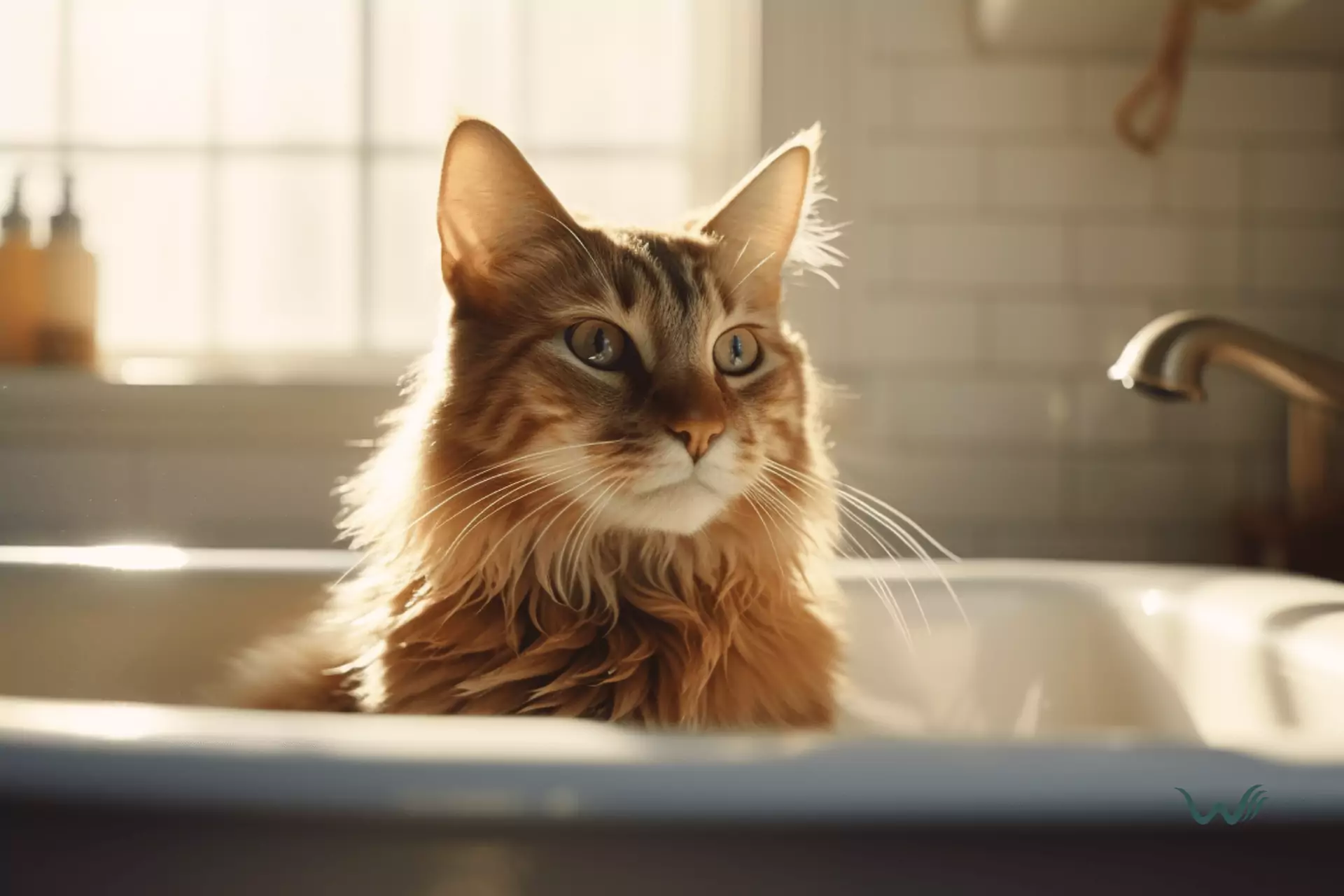

7 Steps For Bathing A Cat
by Haley Mills
Last updated: April 21, 2024
Verified and Approved by:
Angela Morris,
MSW, LCSW
Fact Checked

Bathing a cat can be a challenging and sometimes intimidating task for many pet owners. Cats are known for their aversion to water and their ability to groom themselves with their tongues. However, there are certain situations where bathing your cat becomes necessary, such as when they have gotten into something dirty or when they have fleas. In this article, we will provide a step-by-step guide on how to bathe your cat, ensuring their cleanliness and well-being. By following these seven steps, you can ensure that bathing your cat becomes a more manageable and stress-free experience for both you and your furry friend.
Key Takeaways
- Preparing a warm and quiet environment is essential for bathing a cat.
- Introduce the cat to water gradually and gently to avoid startling or stressing them.
- Use cat-friendly shampoo and thoroughly lather it into their fur, avoiding sensitive areas.
- Dry the cat gently and reward them for cooperating to create a stress-free bathing experience.
Preparing the Bathing Area
Choose a warm and quiet room where you can have privacy, away from any distractions or noise. Make sure the room is well-ventilated to prevent any stuffiness or discomfort.
Before bringing your cat into the bathing area, taking some precautions to prevent escape attempts is important. Close all the doors and windows to eliminate any chances of your cat running away. Cover any small openings or gaps where your cat might try to squeeze through. It’s also a good idea to place a towel or a non-slip mat on the floor to stabilize your cat and prevent accidents.
Additionally, you can place a few toys or treats in the bathing area to help distract and calm your cat during the process. Create a soothing atmosphere to help alleviate any anxiety your cat may have. Soft music or white noise can also help drown out any sudden sounds that may startle your cat.
Gathering the Necessary Supplies
The first item you’ll need is a cat-friendly shampoo. Choose a shampoo specifically formulated for cats, as their skin is more sensitive than ours. Look for a shampoo that is gentle, hypoallergenic, and free of harsh chemicals or fragrances. You can find various cat shampoos at pet stores or online. If you’re unsure which shampoo to choose, consult with your veterinarian for recommendations.
Next, you’ll need a towel or two to dry your cat off after the bath. Opt for a towel that is large enough to wrap around your cat, absorbent, and soft comfortably. Cats can be sensitive to rough textures, so choose a towel that will be gentle on their skin. You may also want to have a grooming brush or comb on hand to help remove any loose fur or tangles before the bath.
Now, let’s address the challenge of bathing a reluctant cat. Some cats are not fond of water and may resist being bathed. It’s important to have a few additional supplies to make the process easier. Consider using a cat-friendly bathing harness or bath bag to help keep your cat secure and calm during the bath. You may also want to have treats or a favorite toy nearby to provide positive reinforcement and distract your cat from the bathing process. Additionally, having a non-slip mat or towel placed in the sink or tub can help your cat feel more secure and prevent them from slipping.
Introducing Your Cat to Water
One effective way to do this is through gradual exposure. Start by filling a sink or basin with a small amount of lukewarm water. Gently place your cat near the water, allowing them to explore and get comfortable at their own pace. Offer treats and praise to create positive associations with the water. Over time, gradually increase the amount of water in the basin, always ensuring that your cat feels safe and secure.
Choosing the right water temperature for your cat is also crucial for a successful introduction to water. Cats are sensitive to temperature, so it’s crucial to find the right balance. Aim for lukewarm water, around 100-102 degrees Fahrenheit. This temperature is comfortable for most cats and will help to make the bathing experience more enjoyable for them.
Avoid using water that’s too hot or too cold, as it can cause discomfort or even injury. Always test the water temperature with your hand or a thermometer before bringing your cat into contact with it.
Applying Cat-Friendly Shampoo
First, you’ll need to gently massage the cat-friendly shampoo into your furry friend’s coat. This will help to clean their fur and remove any dirt or debris thoroughly.
Here are some tips to keep in mind when applying cat-friendly shampoo:
- Using a cat bathing spray: If your cat is particularly anxious or resistant to being bathed, you may want to consider using a cat bathing spray. This spray can help to calm your cat and make the bathing process more enjoyable for both of you.
- Alternatives to traditional shampoo: If your cat has sensitive skin or allergies, you may consider using alternative shampoos. Many cat-friendly shampoos are available specially formulated for cats with sensitive skin or allergies.
- Using a waterless cat shampoo: If your cat really dislikes water, you can try using a waterless cat shampoo. These shampoos are designed to be applied directly to your cat’s fur and do not require rinsing. They can be an excellent option for cats afraid of water or having difficulty getting wet.
- Minimizing water exposure: Cats are generally not fans of water, so minimize their exposure to water as much as possible. Avoid getting water in their ears, eyes, or nose, which can cause discomfort or irritation. Use a gentle touch when applying the shampoo and rinse thoroughly to ensure all the shampoo is removed.
- Drying your cat: After applying the shampoo, dry your cat thoroughly. Use a soft towel to gently pat them dry, being careful not to rub or irritate their skin. You can also use a blow dryer on a low, cool setting to help speed up the drying process.
Rinsing off the Shampoo
Once you’ve lathered up your furry friend, it’s time to rinse off the shampoo and reveal their clean coat. The key to this step is to avoid water splashing and to use a gentle water spray.
Cats are known for their dislike of water, so it’s important to make the rinsing process as stress-free as possible. To start, make sure you have a gentle water spray ready. This can be a handheld showerhead with a gentle setting or a small pitcher filled with lukewarm water.
The key here is to use a gentle stream of water that won’t startle or overwhelm your cat. Slowly and carefully wet their fur, starting from the top of their head and working your way down their body. Avoid getting water in their eyes, ears, and nose to prevent discomfort.
As you rinse, be mindful of any shampoo residue that may still be on your cat’s fur. Ensure to thoroughly rinse all areas, including their belly, legs, and tail. Take your time and be patient, as rushing may cause your cat to become anxious or agitated.
If your cat becomes stressed, take a break and try again later. Remember, the goal is to make the rinsing process as calm and comfortable as possible for your cat. By avoiding water splashing and using a gentle water spray, you can help ensure a positive bathing experience for both you and your feline friend.
Drying Your Cat
After rinsing off the shampoo, gently lift your cat out of the water and place them on a clean towel. Use proper towel techniques to ensure that your cat is dried thoroughly and comfortably.
Begin by gently patting your cat’s fur with the towel, starting from the head and working your way down to the tail. Avoid rubbing vigorously, as this can cause discomfort or tangle the fur. Instead, use a soft and absorbent towel to absorb the excess moisture from your cat’s coat.
If your cat is anxious or nervous, it’s essential to take extra steps to calm them during the drying process. One tip is to use a towel warmed in the dryer for a few minutes. The warmth can provide a soothing sensation for your cat and help them relax. You can also try using a calming spray or pheromone diffuser in the room to create a calming environment. Additionally, speaking to your cat calmly and reassuringly can help alleviate their anxiety.
As you continue to dry your cat, pay attention to any areas that may have retained more moisture, such as the belly or paws. Gently lift and support these areas to ensure that they are thoroughly dried. If your cat has long hair, you may need to use a brush or comb to help remove any tangles or mats that have formed during the bathing process.
What are the additional expenses for bathing a cat?
When owning a cat costs involve bathing, additional expenses may include specialized cat shampoo, a non-slip mat for the tub or sink, and a gentle, absorbent towel. Some owners also opt for a grooming glove or brush to help detangle and shed hair. Regular nail trimming supplies are also essential.
Are the Steps for Bathing a Cat Similar to Caring for a Rescued Turtle?
Yes, the steps for bathing a cat and caring for a rescued turtle are quite different. Bathing a cat involves using cat-friendly soap and warm water, while caring for a rescued turtle includes creating a proper habitat and providing a balanced diet. It’s important to follow the right steps after rescuing turtles to ensure their well-being.
Rewarding Your Cat for a Successful Bath
Choosing the right post-bath treat will ensure that it is a safe and enjoyable experience for your cat. Look for treats specifically designed for cats and made with high-quality ingredients. Avoid treats that are high in sugar or artificial additives, as these can be harmful to your cat’s health. Instead, opt for treats that are made with natural ingredients and are easily digestible. Some popular post-bath cat treats include freeze-dried chicken or fish, catnip-infused treats, or small pieces of cooked chicken or turkey. Remember to moderate the treat to prevent overfeeding and potential weight gain.
You can also reward your cat with a new toy after their bath. Cats are naturally curious and playful, so providing them with a new toy can help distract them from the stress of the bath and keep them entertained. Look for toys that are safe and suitable for cats, such as interactive toys that allow your cat to engage in hunting and pouncing behaviors, or toys that can be filled with treats to provide mental stimulation. It’s important to choose toys that are durable and don’t have small parts that can be easily swallowed.
Finding the best grooming tools for your cat is another way to reward them for a successful bath. Regular grooming not only helps to keep your cat’s coat clean and free of mats, but it also strengthens the bond between you and your pet. Invest in a high-quality cat brush or comb specifically designed for your cat’s coat type. If your cat has long hair, a brush with long, wide-spaced bristles will effectively remove tangles and prevent matting. For short-haired cats, a rubber grooming mitt or a bristle brush will help remove loose hair and distribute natural oils throughout the coat. Additionally, consider using grooming wipes or a gentle cat shampoo to freshen up your cat’s coat between baths. Finding the best grooming tools for your cat can make the grooming process more enjoyable for you and your furry friend.
Conclusion
Bathing a cat can be challenging, but following these 7 steps can make the experience as smooth and stress-free as possible.
First, make sure to prepare the bathing area by closing any doors or windows and placing a non-slip mat in the tub or sink. This will help prevent any accidents and ensure the safety of your cat. Next, gather all the necessary supplies such as cat-friendly shampoo, towels, and a brush. Having everything ready beforehand will make the process much more efficient.
Introducing your cat to water can be a delicate process. Start by slowly and gently wetting your cat’s fur, avoiding getting water in their ears and eyes. Gradually increase the amount of water and use a cat-friendly shampoo to lather their fur. Be sure to rinse off all the shampoo thoroughly to prevent any skin irritation. Once you have finished bathing your cat, be sure to dry them properly. Use a towel to gently pat them dry, being careful not to rub too harshly. If your cat tolerates it, you can also use a blow dryer on a low setting to speed up the drying process.
Finally, don’t forget to reward your cat for a successful bath. This will help them associate bath time with something positive and make future baths easier.
Certify Your Emotional Support Animal Today

Why You Can Rely on Us?
At Wellness Wag, we believe your pet deserves care rooted in both science and compassion. Each article is carefully researched, written in clear language for pet owners, and then reviewed by qualified professionals to ensure the information is evidence-based, current, and practical for real-life care. Our goal is to help you feel confident in making informed decisions about your pet’s health and well-being.
Reviewed by
Angela Morris, MSW, LCSW
Angela is a licensed clinical social worker with 20 years of experience in patient advocacy and community mental health. She has assisted numerous clients with ESA evaluations and brings a deep understanding of disability accommodations, ensuring that all information is accurate, supportive, and practical.

Written by :
Haley Mills
Last Updated :
April 21, 2024











